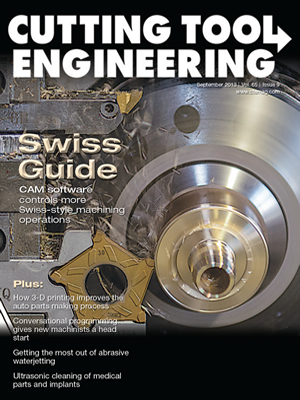I’ve been working with our current tooling distributor or about 3 years, and we have a good working relationship because our company gets good pricing and product support. He doesn’t push top-of-the-line cutting tools, knowing they would be overkill for the jobs we run. His philosophy makes him successful: Provide the customer with the right tool for the job.
My boss had successfully worked with another distributor at his previous company and predicted positive results were we to switch. I initially balked, predicting a lead-in with a high-end toolmaker. Our purchasing person called an introductory meeting. In addition to the purchasing agent and me, in attendance were my boss, the distributor’s application/sales engineer and, sure enough, a sales rep from a high-end tooling company.
A few years back, I had a problem with this same distributor’s sales rep in New England. Of course, I didn’t hold my tongue and made it perfectly clear how I felt about the company and its reps. I also let the application/sales engineer know how I felt about him leading in with a high-end toolmaker when our primary workpiece material is cast aluminum. Several other toolmakers offer cutters that machine aluminum more effectively for a lot less money.
Nonetheless, I wanted to give the distributor a chance. First, we had a cast iron milling application where I was looking for a different boring bar and inserts. He shipped the tools on a Friday for testing the following Monday, but the sales rep was not available until Thursday. I then told the distributor they were not putting their best foot forward, especially when trying to court a new customer.
To make matters worse, the test on Monday did not go well. The tool stalled our spindle because the distributor forgot we must have the inserts set in a stepped configuration in the holder because of the machine tool’s low horsepower. New inserts were then scheduled to arrive the next day.
Come Tuesday, the distributor apologized for not sending the inserts and indicated they would arrive the following day. We received them on Wednesday, but, lo and behold, they were the wrong size. Finally, the correct inserts arrived on Thursday.
On Friday, we finally ran the parts with the correct tools. My initial evaluation determined the operation was four times faster with the new tools than before, saving a few seconds per hole. But it was going to cost more than $1,700 in new tools to bore 699 holes per year—not very cost-effective.
However, I gave the distributor another opportunity, offering to conduct a process improvement plan on one of our parts. The tooling rep informed me he wasn’t available on Tuesday, Wednesday or Friday and wanted us to change our production schedule to accommodate him. Our purchasing person was furious, and I felt the same way. I told the distributor if the rep couldn’t accommodate our schedule, he should select another potential toolmaker from my list of approved ones. The tool rep did find an associate who could be there when we required, but, at his point, it was downhill for the whole lot of them.
Why waste everyone’s time courting a new customer if you aren’t prepared to accommodate them?
My initial vendor is still the vendor of choice for our company. They’ve worked hard to keep us as a customer, and my boss agrees they do a good job, especially compared to many other distributors. Those distributors will have an extremely tough time getting our business. CTE
About the Author: Mike Deren is a manufacturing engineer/project manager and a regular CTE contributor. E-mail: [email protected].Related Glossary Terms
- boring
boring
Enlarging a hole that already has been drilled or cored. Generally, it is an operation of truing the previously drilled hole with a single-point, lathe-type tool. Boring is essentially internal turning, in that usually a single-point cutting tool forms the internal shape. Some tools are available with two cutting edges to balance cutting forces.
- boring bar
boring bar
Essentially a cantilever beam that holds one or more cutting tools in position during a boring operation. Can be held stationary and moved axially while the workpiece revolves around it, or revolved and moved axially while the workpiece is held stationary, or a combination of these actions. Installed on milling, drilling and boring machines, as well as lathes and machining centers.
- gang cutting ( milling)
gang cutting ( milling)
Machining with several cutters mounted on a single arbor, generally for simultaneous cutting.
- milling
milling
Machining operation in which metal or other material is removed by applying power to a rotating cutter. In vertical milling, the cutting tool is mounted vertically on the spindle. In horizontal milling, the cutting tool is mounted horizontally, either directly on the spindle or on an arbor. Horizontal milling is further broken down into conventional milling, where the cutter rotates opposite the direction of feed, or “up” into the workpiece; and climb milling, where the cutter rotates in the direction of feed, or “down” into the workpiece. Milling operations include plane or surface milling, endmilling, facemilling, angle milling, form milling and profiling.


